New features have been put into the design of RFQ
accelerators, which result in small emittance growth, reduce the
length of the RFQ structure and can be used to improve the matching
to the following linac, buncher, chopper or funneling line. Design
examples are presented for the new high current linac at GSI,
for the ESS study, and for the HIIF injectors.
The interest in high intensity particle beams has been pushed by high energy and heavy ion physics demands as well as by applications like neutron sources, military material testing, and inertial confinement fusion. The work on ion sources, injectors and accelerator structures has increased the pulse as well as the average current significantly.
Injectors are a combination of an ion source, a low energy beam transport line (LEBT), a preaccelerator, mostly an RFQ, and an intermediate matching section (IMS) which matches the beam to a following structure e.g. an IH or an Alvarez accelerator. Despite being relatively short, the injector defines the phase space density for the following stages in which the effective emittance can only grow. The development of the RFQ (Radio Frequency Quadrupole)-structure was a major step for the improvement of injectors [1,2]. It is giving the option of high overall transmission from the ion source dc-beam to a well bunched beam.
The variety of RFQ-accelerators covers the full ion
mass range from H to U, frequency range from 5-500 MHz and
duty factors from below 0.01 up to 100% [3,4]. The physics of
transport and acceleration of high current ion beams in RFQs have
been solved to such extent, that the best beams, which can be
produced by ion sources and transported in a LEBT, can be captured
and transmitted with very small emittance growth by RFQs.
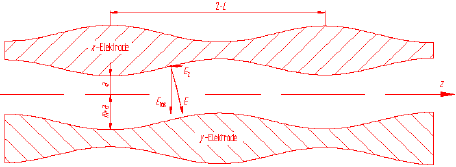
The RFQ basically is a homogeneous transport channel with additional acceleration. The mechanical modulation of the electrodes, as indicated in figure 1, adds an accelerating axial field component, resulting in a linac structure which accelerates and focuses with the same rf fields. For a given injection energy and frequency the focusing gradient G=X*UQ/a2; (X<1 for modulated electrodes) determines the acceptance in a low current application. A maximum voltage UQ has to be applied at a minimum beam aperture a , if the radial focusing strength is the limiting factor. The highest possible operating frequency should be chosen to keep the structure short and compact. Besides the choice of UQ and operating frequency f of the "RFQ design", the values of aperture a, modulation m and the length LC along the RFQ, determine the electrode shape (pole tips) and the beam properties.
The principles of "RFQ design" are based on early work at ITEP and LANL. The spatial homogenoues focusing and adiabatic bunching AB, where the beam is continuously bunched and accelerated with small axial fields, are basic ingredients of the RFQ to which sections for the radial- RM and axial matching (shaper) SH to the dc-beam have been added. The last part of the RFQ is the accelerator section ACC where the synchronous phase and the modulation or the axial field are kept constant like in a normal linac.
This is the basic content of the RFQGEN and RFQUICK codes and its relatives which generate parameter sets for the RFQ electrodes and the input for the simulation code PARMTEQ [5], which is a reference multiparticle code to study the transport of the beam through the cells of an RFQ and check emittances and losses. These successful tools have been used with some minor variations for a number of injectors and for the generation and studies of space charge dominated beams.
For low current heavy ion beams first major changes have been introduced. For the MSI injector and later on for the second injector at SATURNE a prebuncher with only a few cells followed by a short drift has been put into the first part of the RFQ without adiabatic bunching to reduce the length and power consumption of this injector. Also current limits or tune depressions have been used as design criteria along the RFQ rather than synchrotron frequencies to increase the overall currents [6].
In the development for the GSI-HLI-RFQ designs have been studied, in which basically all parameters were varied adiabaticly with a decreasing radial sr and longitudinal sl like a broad hill resulting in short RFQs with rather low long emittances and a very small radial emittance growth without shaper, adiabatic bunching and ACC sections [7]. Surprisingly this method could also be applied for high current proton RFQs resulting in beam properties, which could be achieved only with rather long classical designs. It should be mentioned, that these designs are independent of the kind of RFQ rf-structures used.
In the following examples of RFQs are presented,
which make use of these design features. In addition new accelerator
sections are added, which give an improved matching to the following
IMS and accelerator stages.
The GSI accelerator facility consists of the 18 Tm
Heavy Ion Synchrotron (SIS) and the Experimental Storage Ring
(ESR). In order to feed these rings up to their space-charge limit
a new High Current Injector (HSI - Hochstrominjektor)
is under construction now [8], consisting of a 36 MHz RFQ
and a IH linac from 120 keV/u to 1.4 MeV/u as shown
in Fig. 2.

The HSI-RFQ electrode design follows the method used
for the Spiral-RFQ prototype which has been built for rf-testing
as well as for beam experiments [9, 10]. A very short IMS line
to the IH-linac with an RFQ-lens has been selected to provide
the special shape of the beam to the IH-linac with radially and
longitudinally converging beam ellipses. To produce the longitudinal
profile the beam has to drift first and then has to be rebunched.
To reduce the IMS length the accelerator section of the RFQ has
been modified in a way that in the last cells the stable phase
was shifted to zero, to accelerate the beam without restoring
force. The electrode parameters are shown in fig. 3, the output
distribution for the design input current of 16.5 mA for
U4+ is shown in fig. 4, with only 10% emittance
growth in the RFQ.
Table 1: Main parameters of the HSI RFQ.
For a given emittance of an ion beam the current limit for rf-accelerators is proportional to the ion velocity and to the rf-wavelength, assuming rf-electrical focusing and field strength limitations. Due to the limited perveance of the ion sources a significant increase in beam current can be achieved e.g. by funnelling, which in an ideal case, doubles the ion beam without increase of emittance by a zipper like combining of bunches and doubling of the accelerator frequency. Examples where funnelling is essential are the spallation sources studies e.g. ESS [11] and Heavy Ion Inertial Fusion- (HIIF-) injector schemes which have the typical tree of injectors. For the first funneling stage a new two-beam RFQ, where two beams are bunched and accelerated in a single rf cavity has been proposed, as shown Fig. 5.
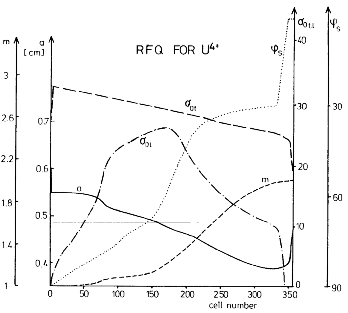
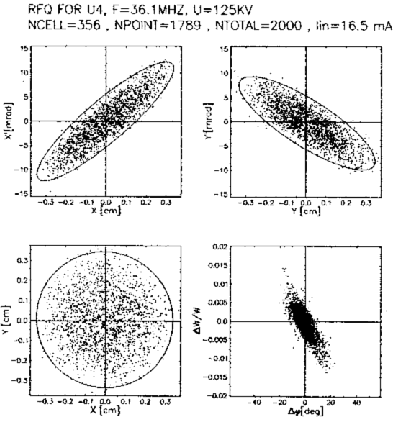
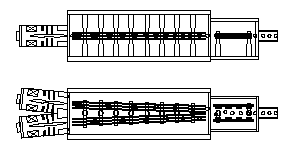
The two-beam RFQ consists of two sets of convergent quadrupole electrodes driven by one resonant structure. This brings the two beams very close together while they are still radially and longitudinally focused. A short funneling deflector at a rather low voltage placed directly behind the twin beam RFQ will combine the beams.
Matching to the funnel deflector will be done with
the RFQ. The emittance growth in an rf-funnel deflector is minimal
for a point-like bunch. So a x,y focus is in the midth of the
funnel deflector, while the axial focus should be somewhat later
to match also to a transport line to the next accelerator stage.
This has been achieved by a modified ACC section of the RFQs:
A drift section DS with a number of cells with reduced sychronous
phase and focusing strength is followed by refocusing cells RF,
rebunching cells RB and a matching out MO section.
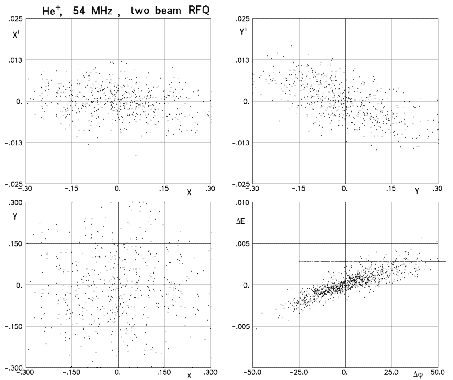
Fig. 6 shows results for the beam distribution at
the funnel location. The simulation was done for a He+
beam funneling experiment under way at the IAP [12]. The beam
is converging in the x,y,z planes, although not totally symmetric.
This beam shaping facilitates the funneling and should reduce
emittance growth in the funneling line. It can be adopted e.g.
to a high current chopping line as well, where the beam has to
drift in the deflector without focusing [11].
Beam dynamics design procedures have been investigated by many authors, with mostly small deviations from the basic approach given by the ITEP and LANL groups, where the main work concentrated on high flying RFQs, emittance growth mechanism, halo formation and beam losses. The smooth parameter variation approach discussed above does not help in all cases but e.g. surprisingly helps keeping equipartitioning in the RFQ and small emittance growth [13,14]. The adding of a debuncher section was first done for the first SATURNE-RFQ [15] (no space charge), resulting in a rather long RFQ-structure. The short second SATURNE-RFQ worked with an internal prebuncher, like the MSI-RFQ, and an external debuncher [16]. The new designs for the HSI and the Two beam experiment have a DS incorporated into the ACC-section, and the radial focusing for both planes is added in the twin-beam structure example.
The smooth parameter variation design procedures
also are used to reduce the power requirements of ion RFQs, which
is an important parameter for applications. In low current applications
the power has been reduced by more than 50% with only small reduction
in acceptance and transmission [17].
I want to acknowledge the members of my group for
support and help in beam dynamics as well as in computer questions,
and especially H. Deitinghoff as reference point in beam dynamics,
and colleagues from collaborations who always ask for more for
less.
[1] I.M. Kapchinskiy and V. Teplyakov,
Linear Ion Accelerator with spatially homogeneous strong focusing,
Prib. Tekh. Eksp 119, No.219 (1970)
[2] R. Crandall, R.H. Stokes, T.P. Wangler, RF Quadrupole Beam Dynamics Design Studies, LINAC79, BNL 51134 (1979) 205
[3] A. Schempp, RF Quadrupole as Accelerators, Advances of Accelerator Physics and Technology, World Scientific (1993) 194
[4] A. Schempp, The Application of RFQs,
LINAC92, AECL 10728 (1992) 545
[5 ] PARMTEQ code, LANL
[6] A. Schempp, Design of compact RFQs, EPAC88 (1988) 464
[7] J. Friedrich, A. Schempp, H. Deitinghoff, U. Bessler, H. Klein, R. Veith, Properties of the GSI HLI-RFQ Structure,
PAC91, IEEE91CH3038 (1991) 3044
[8 ] U. Ratzinger, The new GSI Prestripper Linac for High Current heavy Ion beams, these proceedings
[9] A. Schempp, H. Deitinghoff, A. Kipper, 27 MHz Heavy Ion Spiral RFQ Development, Nucl. Instr. Meth. A278 (1989) 169
[10 ] U. Bessler et al. Experiments with the High Current Spiral RFQ Prototype, these proceedings
[11] J. Madlung, A. Firjahn-Andersch, A. Schempp, Chopping- and Funneling Studies for ESS at Frankfurt, PSI-Proc. 95-02 (1995) 736
[12] A. Firjahn Andersch et al., A novel Design for Ion Beam Funnelling by the use of a Two beam RFQ and a Multigap Deflector, these proceedings
[13] D. Li, R.A. Jameson, H. Deitinghoff, H. Klein, Particle Dynamics design Aspects for an IFMIF D+ RFQ, Proc. of EPAC96
[14] R. Ferdinand, J.M Lagniel,P. Mattei, RFQ design for High Intensity proton beams, IFMIF-ATM Santa Fe (1995) 345
[15] M. Olivier, First heavy Ion Acceleration in Saturne, LINAC84, GSI-Rep 84-11(1984) 59
[16] J.L. Lemaire, P. Beauvais, P. Chamouard, R. Ferdinand, Recent Performance of the LNS Four-Rod RFQ2, LINAC94 (1994) 719
[17] A. Schempp, REX-RFQ Design, IAP-Rep. 96-S12